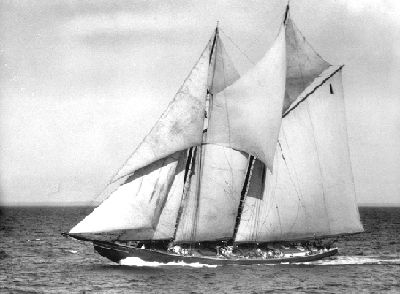As a symbol of Atlantic Canada and the golden age of sail, the Bluenose has no peer. She was launched in Lunenberg, Nova Scotia, 26 March 1921. Built entirely of Nova Scotia wood (except for the Oregon pine needed for the masts), Bluenose bobbed high in the water but settled down to her beautiful line as the ballast was poured in. When the finishing touches were being applied, the shipwright was asked, "What is this one going to be like?" "She will be all right, but she is a bit different to most vessels," was the understated reply.

As the schooners arrived home from the Grand Banks in 1920, word spread among the fishermen that the America's Cup race off Sandy Hook, New York, had been postponed because of a mere "breeze." The fishermen had contempt for those effete "yachts," which huddled by the docks when the seas ran high. They persuaded Senator W.H. Dennis, the owner of the Halifax Herald, to donate a new trophy — the International Fishermen's Trophy — for real schooners that could work the Grand Banks as well as race like thoroughbreds.
When the Canadian schooner Delawana lost the first match to the Gloucester schooner Esperanto, there was dismay in Nova Scotia. The search for a new design that would bring the trophy home led to William J. Roue and his masterpiece, Bluenose.
In October 1921, Bluenose defeated seven other Nova Scotia schooners and qualified to challenge for the trophy. Later that month, she showed in her match against the American defender Elsie that she could carry sail and go to windward — and that she was fast. She won both races with ease and came home with the trophy.
Bluenose defended the trophy in October 1922 against the Henry Ford, which had been launched with the sole purpose of humbling her. Then came Columbia in 1923. The two were so close in the first race that they collided. Columbia was fast but Bluenose proved more "able." When the judges awarded Columbia the second race on a questionable technicality, the Bluenose’s skipper, Angus Walters packed up the trophy and went home. In a grim reminder that these were working vessels, Columbia, like Esperanto before her, was lost at sea.

Enthusiasm for the race was not rekindled until 1929, with the launch of the Gertrude L. Thebaud. Small and winsome, it was said that Thebaud had the "air of a Boston debutante." In 1930, Thebaud defeated Bluenose in the Lipton Cup, the Nova Scotian's only loss. In the showdown for the International Trophy off Halifax in 1931, Bluenose easily won both races. Thebaud was not even in sight when Bluenose crossed the line."You know it was kinda lonely out there today," Walters said, "Thebaud wasn't any company at all."
By 1938, a reluctant Captain Walters had to be persuaded to take the old campaigner to Boston for one last race. Grounded and beaten by hurricanes, Bluenose had taken on so much water over the years that she needed 40 per cent less ballast.
On 9 October 1938, Bluenose had her fore-topmast carried away and lost the first race by almost three minutes. After some repairs, she romped home 13 minutes ahead in the second race and on October 17 won the third by six minutes and 39 seconds.
Since the Americans had insisted on a best of five, the match was not over. Bluenose opened up a lead in the fourth race but a sharp maneuvre opened a 12 m-long rip in the staysail. Walters barked out an order to "Get it down." The rigger had his sail bag ready and within 10 minutes had the sail herring-bone stitched top to bottom and ready to be hoisted. The order "hard a-lee" came and the vessel tacked with the staysail up again. Bluenose was well ahead, but then suddenly the fore-topmast stay came loose and snapped. Thebaud sailed past and the score was 2–2.
"She's not at her best, that's sure," Walters admitted, "but someone has to win — and it's not over yet." In the final race, Walters built a slight lead and kept it until the last leg when her topsail halyard block gave way. The lead shrank. Walters ordered a short tack to "fetch the line" and Bluenose crossed the line a scant two minutes and 50 seconds ahead.
"I gave her the power to carry sail," said the designer William Roue. Many theories have been put forward to explain why Bluenose showed such fantastic superiority in every aspect of sailing. One is that she was lean — 44 m long with a keel of only 15 m. Another was that her hull was set in a cold Nova Scotia winter. Indisputable, though, was the seamanship of her indomitable skipper, Angus Walters, who summed up his beloved schooner this way: "The wood of the vessel that will beat the Bluenose is still growing!"
See also Bluenose; Yachting; Sailing Ships; Shipbuilding and Ship Repair.

 Share on Facebook
Share on Facebook Share on X
Share on X Share by Email
Share by Email Share on Google Classroom
Share on Google Classroom